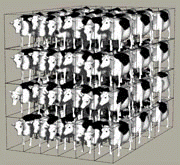Animal Science, Department of

World Congress on Genetics Applied to Livestock Production: 3rd (1986)
Date of this Version
1986
Abstract
Only very recently buffaloes have been studied deeper for a better breeding and for emphasizing their meat productive potentiality and its physiological, chemical and organolptic qualities.
Very good investigations, conducted mainly in Australia, Bulgaria, Italy, Thailand and Trinidad show in an univocal way, if the buffaloes are reared and fed well, that the daily gain, the percentage of fessing and of the first cut, the organoleptic characteristics are quite similar and sometime also better than those of bovine cattle. The best slaughter tiie is at 14-16 months of age when the live weight is of 350-380 kg with a 52-58 percent of dressing. The A. emphasizes the use of balanced food in function of the different environmental situation, of appropriate breeding techniques and the application of a selective program for the development of genetic lines with high food conversion index to increase considerably the availability of buffalo meat.
Also, the opportunity is emphasized of extending the A.P.He.A. (Animal Production and Health Association) to every buffalo breeding country for fixing a research protocol to compare the different results so to plan a common approach in the buffalo research.


Comments
Published in 3rd World Congress on Genetics Applied to Livestock Production, edited by Gordon E. Dickerson and Rodger K. Johnson, 4 vols. (Lincoln: University of Nebraska Institute of Agriculture and Natural Resources, 1986). Copyright © 1986 Board of Regents University of Nebraska.